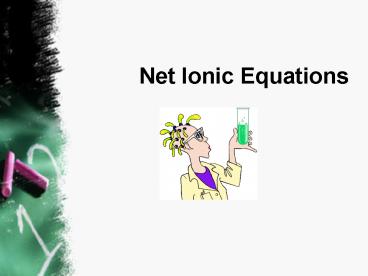Net Ionic Equations PowerPoint PPT Presentation
1 / 15
Title: Net Ionic Equations
1
Net Ionic Equations
2
What are they?
- Net ionic equations are equations that show only
the soluble, strong electrolytes reacting (these
are represented as ions) and omit the spectator
ions, which go through the reaction unchanged. - They are the bare bones of the chemical reaction.
3
Where do they take place?
- They usually take place in aqueous (aq)
environments. - To write them you need to understand solubility
rules. (These are summarized on your activity
series chart).
4
Solubility Rule Highlights
- Most alkali metal compounds and NH4 compounds
are soluble. - Cl-, Br-, I- compounds are soluble, except when
they contain Ag, Hg22, or Pb2. - F- compounds are soluble, except when they
contain group 2A metals. - NO3-,ClO3- , ClO4- and CH3COO- compounds are
soluble. - SO42- compounds are soluble, except when they
include Ca2, Sr 2, Ba 2, Ag , Pb 2, or
Hg22. - CO32-, PO43-,C2O42-, CrO42-, S2-, OH-, and O2-
compounds are insoluble. - All nitrates (NO3-) are soluble.
5
How do we write them?
- Write a balanced equation for the reaction
showing all states! - Rewrite the equation, breaking apart soluble
compounds (reactants and products) intoions
where appropriate. - Cancel all spectator ions and rewrite the
remaining net ionic equation.
6
Some Other Guidelines
- All ionic substances in aqueous form in the
nonionic equation are written as separate ions. - All acids in aqueous form in the nonionic
equation are written as separate ions - All solids, liquids and gases are written
unchanged.
7
Example (Single Replacement)
- Complete Molecular Equation
- Zn (s) 2 HCl (aq) ? ZnCl2 (aq) H2 (g)
- Now we need to evaluate the products and
reactants and write a complete ionic reaction
8
Think it through
- Zinc is a solid so is left alone Zn (s).
- HCl is an acid in aqueous form so is written as
separate ion 2 H (aq) and 2 Cl - (aq) . - ZnCl2 (aq) is an ionic substance so is written
as separate ions Zn 2 (aq) and 2 Cl- (aq). - Hydrogen is a gas and is therefore left alone
H2 (g).
9
Write Complete Ionic Equation
- Zn (s) 2H(aq) 2Cl -(aq) ? Zn 2(aq)
2Cl-(aq) H2(g)
Now we need to evaluate the products and
reactants, find and eliminate any spectator ions,
and write a net ionic reaction
10
Identify Spectator Ions
- Zn (s) 2H(aq) 2Cl -(aq) ? Zn 2(aq)
2Cl-(aq) H2(g)
A spectator ion DOES NOT CHANGE during the
reaction. If it is the same on both sides of the
reaction, it did not participate!
11
Write Net Ionic Equation
- Zn (s) 2H(aq) ? Zn 2(aq) H2(g)
The net ionic equation only shows the reactants
and products that actually participated in the
reaction.
12
Same for Double Replacement!
- Complete Molecular Equation
- NaCl (aq) AgNO3 (aq) ---gt AgCl(s) NaNO3 (aq)
13
Solubility Rules Revisited
- Notice that AgCl (s) is an INSOLUBLE salt.
- Thats why learning and using the solubility
rules is so important!
14
Same for Double Replacement!
- Write Complete Ionic Equation
- Na(aq) Cl- (aq) Ag(aq) NO3-(aq) ? AgCl(s)
Na(aq) NO3-(aq)
Identify Spectator Ions Na(aq) Cl- (aq)
Ag(aq) NO3-(aq) ? AgCl(s) Na(aq) NO3-(aq)
15
Same for Double Replacement!
- Write Net Ionic Equation
- Ag(aq) Cl-(aq) ? AgCl(s)
- Notice that since AgCl(s)
- is an INSOLUBLE solidyou cannot break it into
ions!

